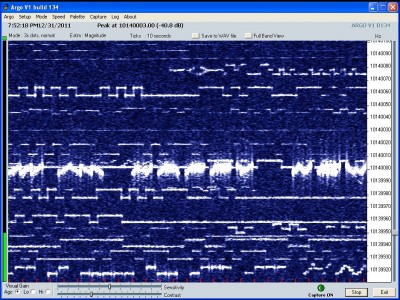I recall burning three or four weeks of a sabbatical getting Saccade.com on the air with Wordpress. So much tweaking…
K6HX QRSS Beacon ON AIR…
Well, this morning I did a bit more work on my G0UPL beacon kit. As I mentioned yesterday, I got was having difficulty with the frequency swing: despite a very tightly wound gimmick, I was getting just a little over 1Hz or frequency shift. Late last night I decided to just try a new one: there obviously had to be a fault there. Sure enough, I wound a new one, installed it, and was suddenly getting 30Hz of frequency shift! Feast or famine, isn’t that the way of it? I trimmed it down, and unwound it a bit, and now am getting a nice, reasonable 4Hz or so swing, which is clearly visible in Argo, but also narrow enough to be tidy.
I had also noticed during testing that the QRSS beacon controller was powering up in 15s/dit mode, which is a tad too slow even for the patient. I then decided to take notice of the “Important Notice” on Hans’ documentation, and grounded pins five and six with a small jumper on the bottom of the board. It now powers up reliably in six second per dit mode.
I then decided to try to measure the output power. And… on the antenna terminals, I was measuring, well, nothing! That’s not good. I then backtracked to the 2N7000 FET, and found that there was indeed a signal on the Gate, and it was modulating (although the waveform looked pretty wonky). Probing various places along the filter chain quickly discovered the bad solder joint, and I had power.
I then tried to do some adjustment of the output power. I wired up a 2W 47 ohm resistor as a dummy load, and hooked up my scope. I found that if I peaked the output power with just under six volts peak-to-peak (a little less than 100mw) the 2N7000 got fairly toasty hot. I backed off the power to just 4 volts peak to peak (around 40mw) and the transistor seems fairly calm. I thought I should be able to do a bit better, but 40mw isn’t all that bad, so… I decided to get it on the air.
And here it is, appearing on KK7CC’s grabber (click to get it live), right around 10.140040 Mhz:
It works! KK7CC is in Las Vegas, which is around 560 miles from my location. Not bad for 40mw output power.
I’ll leave this up for a while, I’m interested in getting reception reports and screen grabs at my ARRL mailbox. I will eventually take it down, get it mounted inside a nice little Altoids box, and perhaps figure out why the output power is well short of the 100mw that I should be able to pull out of it.
In the mean time, I hope everyone has a safe and happy New Year’s Eve!
Comments
Comment from Kevin ZL1UJG
Time 1/14/2012 at 11:06 am
Changing the capacitors definitely improves the output power by more than 100% typically on 30m. New capacitors in the LPF would help that. But it is also prudent in change the the other ones. Having unknown capacitors in the oscillator may also cause frequency instability problems.

Comment from Robin
Time 1/3/2012 at 2:56 am
Mark
You may want to look at the paper written by Kevin Murphy ZL1UJG. He has analyzed the pathology of some instances of low power output from Hans’ fabulous little kit, and has suggested some capacitor changes (to NP0 types) that improve the power output. His paper is hosted at http://qsl.net/dl1gsj/The_Molded_Mud_Saga.pdf